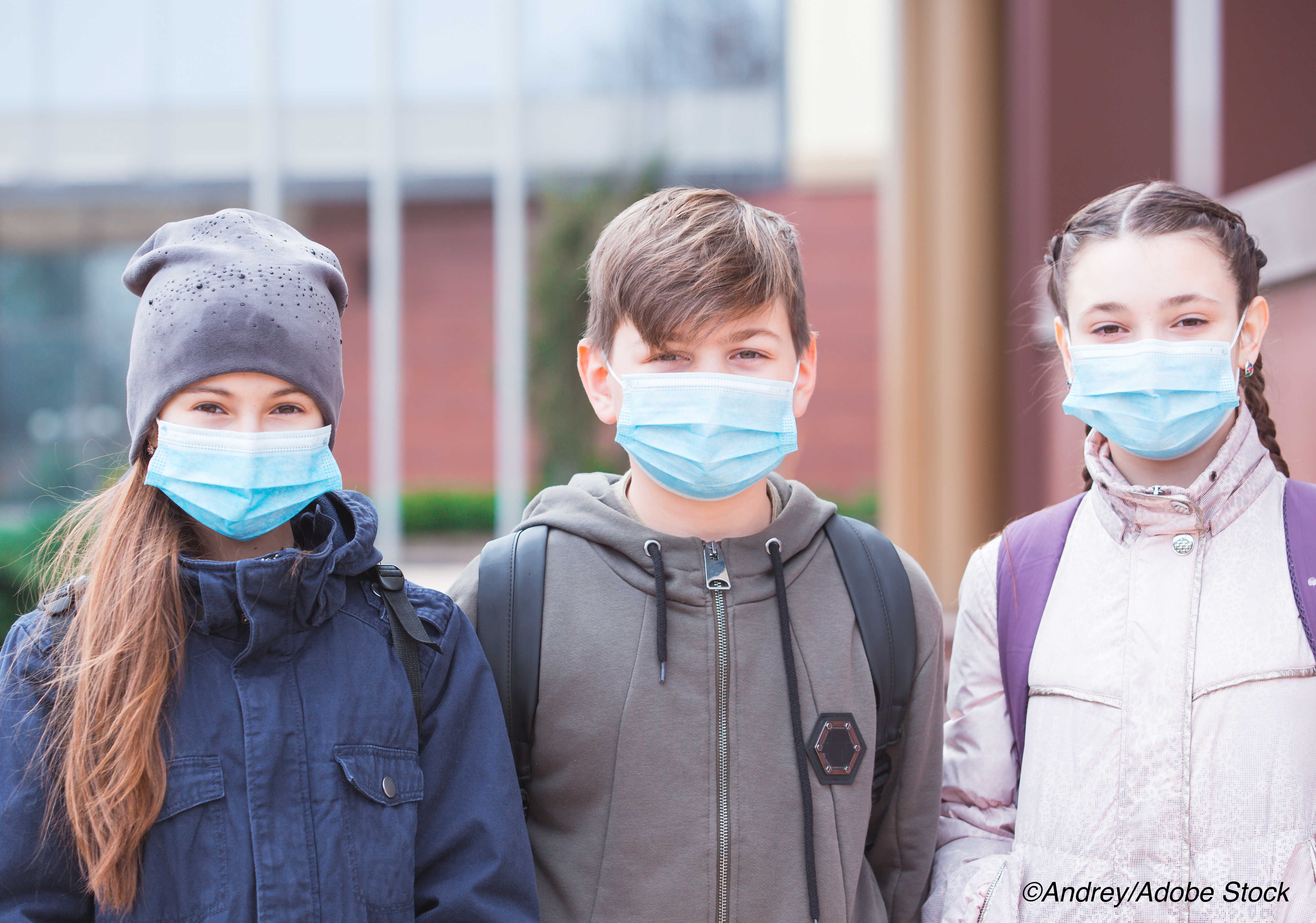
When it comes to Covid-19 transmission, there doesn’t appear to be a significant difference between children and adults. What matters, according to a cross-sectional study, is SARS-CoV-2 RNA levels or viral load, with symptomatic individuals having a higher viral load than those who are asymptomatic.
In the study, which is published in JAMA Pediatrics, Erin Chung, MD, from the University of Washington School of Medicine, Seattle, and colleagues used reverse transcription-polymerase chain reaction (RT-PCR) cycle threshold (Ct) values to approximate viral load. “Studies have shown a strong association between lower Ct values (higher RNA levels) and successful isolation of SARS-CoV-2 in culture,” Chung and colleagues wrote. “Early case reports showed that asymptomatic individuals had levels of detectable SARS-CoV-2 RNA comparable with symptomatic individuals, and this observation has been supported by a growing body of evidence from larger community based studies in predominantly adult populations.”
Chung and colleagues wanted to do a deeper dive on viral load to see how children compare with adults vis-a-vis asymptomatic versus symptomatic transmission.
“This countywide community-based study of SARS-CoV-2 infection in King County, Washington, showed that symptomatic individuals had lower Ct values than those who were asymptomatic,” the study authors wrote. “Ct values did not differ significantly between asymptomatic children versus asymptomatic adults or in symptomatic children versus symptomatic adults. This study was unique in that participant-driven community-wide surveillance was instituted in a large metropolitan area using methods without direct participant contact and directed at persons who were not actively seeking medical care or follow-up.”
The findings reported by Chung and colleagues can help inform how the country reopens schools, as well as daycare and preschool, in a safe manner, Christina A. Rostad, MD, from the Department of Pediatrics, Emory University School of Medicine, in Atlanta, Georgia, and colleagues note in an editorial accompanying the study.
“Our increasing understanding of transmission dynamics among children informs decisions about in-person learning. The [CDC] emphasizes that kindergarten through 12th grade schools can resume in-person learning through phased reopening, and prioritization of the correct and consistent use of masks and physical distancing,” Rostad and colleagues wrote. “Layering prevention strategies, including teacher masking, daily symptom screens, and appropriate isolation and quarantine, further reduces transmission risk in schools.”
The editorialists noted that the study from Chung and colleagues “underscores the potential transmission risk of symptomatic children and the importance of isolating while symptomatic. Keeping symptomatic children home would have benefits for prevention not only of SARS-CoV-2, but also of influenza, respiratory syncytial virus, and other infectious pathogens. Additionally, extracurricular activities are important in SARS CoV- 2 transmission, and measures to prevent transmission should be used.”
In their study, Chung and colleagues analyzed data that had been collected as part of the Seattle Coronavirus assessment Network (SCAN) that surveilled individuals from March 23 to Nov. 9, 2020. They also included a convenience sample of children <18 years old as well as adults enrolled online for self-collection of SARS-CoV-2 testing.
The main outcome of the study was RT-PCR-confirmed SARS-CoV-2 infection with Ct values stratified by age and symptoms.
More than 37,000 swab samples were analyzed, from which 123 children and 432 adults tested positive for SARS-CoV-2. The mean age of the 555 participants was 33.7 (7.5 years for children and 41.2 for adults), and most (57.5%; n=432) were female.
Among their findings:
- Of the children who tested positive for SARS-CoV-2 — 50 were younger than 5 years; 445 were age 5-11, and 28 were age 12-17.
- Most of the children testing positive were female, 44.7% were White, and 24.4% were Hispanic or Latino.
- Seasonal allergies and asthma were the most common underlying conditions in 9 and 5 children, respectively. Most children did not have other underlying medical conditions.
- The household size of those who tested positive was larger than the mean household size in the county (2.4 people), with 3.8 being the mean household size of those in the study.
- 47 of 123 (38.2%) children versus 31 of 432 (7.2%) adults were asymptomatic.
- Fewer children were symptomatic compared with adults (76 of 123 children [61.8%] versus 401 of 432 adults [92.8%]; P< .001).
- Children who were symptomatic had fewer symptoms than their adult counterparts (mean [SD], 1.6 [2.0] versus 4.5 [3.1]).
- Those with symptoms had lower Ct values and thus higher viral RNA levels than those who were asymptomatic (adjusted estimate for children, −3.0; 95% CI, −5.5 to −0.6; P= .02; adjusted estimate for adults, −2.9;95%CI, −5.2 to −0.6; P= .01).
- There was no statistically significant difference in the mean Ct values between those who were symptomatic, whether adults or children (adjusted estimate, −0.7; 95%CI, −2.2 to 0.9; P= .41), and the same held between those who were asymptomatic (adjusted estimate, −0.6; 95%CI, −4.0 to 2.8; P= .74).
“Overall, children with documented SARS-CoV-2 infection in our study were younger, with 40% younger than 5 years, than in other community-based studies,” Chung and colleagues wrote. “A variety of signs and symptoms were reported by SARS-CoV-2–positive children or their caregivers, with runny nose documented in nearly half of the children, followed by fever, headache, and cough. The predominance of rhinorrhea contrasts with other studies, which have shown fever and cough to be more common symptoms. The variation in symptoms and lack of predictive value of specific symptoms have been suggested as reasons for failure of symptom-based testing when screening children for Covid-19.”
The study authors pointed out that their study was not designed to assess the prevalence of asymptomatic Covid-19. “The high proportion of asymptomatic infection we observed in children is within the upper limit of the asymptomatic ranges of 40% to 45% estimated in other studies,” they wrote. “The high proportion of asymptomatic infection we observed in children might be attributed to household enrollment of children following interest in study participation from adults with symptoms. The true frequency of asymptomatic SARS-CoV-2 infection might be closer to 16% to 22%, as suggested by other pediatric studies.”
Limitations of the study include reliance on individuals to request home testing kits, as well as the requirement that individuals be familiar with the study and also have Internet access, which could limit its generalizability.
-
When it comes to Covid-19 transmission, there doesn’t appear to be a significant difference between children and adults. What matters, according to a cross-sectional study, is SARS-CoV-2 RNA levels or viral load, with symptomatic individuals having a higher viral load than those who are asymptomatic.
-
In this study, symptomatic individuals had lower cycle threshold (Ct) values than those who were asymptomatic, and these Ct values did not differ significantly between asymptomatic children versus asymptomatic adults, or in symptomatic children versus symptomatic adults.
Candace Hoffmann, Managing Editor, BreakingMED™
Chung disclosed no relevant relationships.
Rostad’s institution has received funds to conduct clinical research unrelated to this article from BioFire Inc, MedImmune, Regeneron, PaxVax, Pfizer, GlaxoSmithKline, Merck, Novavax, Sanofi Pasteur, Janssen, and Micron; she is also coinventor of patented respiratory syncytial virus vaccine technology unrelated to this article, which has been licensed to Meissa Vaccines, Inc.; and she reports support from the National Institutes of Health to conduct Covid-19 vaccine and other vaccine clinical trials, paid to her institution.
Cat ID: 190
Topic ID: 79,190,730,933,190,926,138,192,927,151,928,925,934


